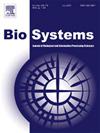理解自然对遗传语言的选择
IF 2
4区 生物学
Q2 BIOLOGY
引用次数: 0
摘要
所有生物体在其分子生物学机制中都使用两种通用的遗传语言,一种包含4个核苷酸碱基,另一种包含20个氨基酸。它们可以被理解为它们所执行的任务的遗传信息的最佳编码,即DNA/RNA的复制/转录和多肽链的翻译。这些任务通过互补的核苷酸碱基配对,从细胞中的分子集合中选择所需的字母。这个过程的计算机科学范式是数据库搜索;可以根据找到正确的核苷酸碱基配对所需的尝试(或查询)次数来构建和比较各种算法。Grover的基于振荡波动力学的搜索算法完全符合搜索遗传字母所需的查询数量,并且比需要大量查询的最佳布尔搜索算法(即二叉树搜索)效率更高。这一结果有力地表明,通用的遗传语言已经被进化选择为它们执行任务的最佳字母,而不是历史的偶然。最突出的挑战是演示格罗弗的搜索算法如何在活体中被生物体执行。本文章由计算机程序翻译,如有差异,请以英文原文为准。
Understanding nature’s selection of genetic languages
All living organisms use two universal genetic languages in their molecular biology machinery, one containing four nucleotide bases in its alphabet, and the other containing twenty amino acids in its alphabet. They can be understood as the optimal encodings of genetic information for the tasks they carry out, i.e. replication/transcription for DNA/RNA and translation for polypeptide chains. These tasks select needed letters of the alphabet by complementary nucleotide base-pairing, from a collection of molecules in the cell. The computer science paradigm for this process is database search; various algorithms for it can be constructed and compared according to number of attempts (or queries) they need to make to find the correct nucleotide base-pairing. Grover’s search algorithm based on oscillatory wave dynamics perfectly fits the number of queries needed to search the genetic alphabets, and it is more efficient than the best Boolean search algorithm (i.e. binary tree search) that needs a larger number of queries. This result strongly suggests that the universal genetic languages have been selected by evolution as the optimal alphabets for the tasks they carry out, and are not an accident of history. The outstanding challenge is to demonstrate how Grover’s search algorithm would be executed in vivo by the living organisms.
求助全文
通过发布文献求助,成功后即可免费获取论文全文。
去求助
来源期刊

Biosystems
生物-生物学
CiteScore
3.70
自引率
18.80%
发文量
129
审稿时长
34 days
期刊介绍:
BioSystems encourages experimental, computational, and theoretical articles that link biology, evolutionary thinking, and the information processing sciences. The link areas form a circle that encompasses the fundamental nature of biological information processing, computational modeling of complex biological systems, evolutionary models of computation, the application of biological principles to the design of novel computing systems, and the use of biomolecular materials to synthesize artificial systems that capture essential principles of natural biological information processing.
 求助内容:
求助内容: 应助结果提醒方式:
应助结果提醒方式:


